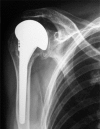Use of cuff tear arthroplasty head prosthesis for rotator cuff arthropathy treatment in elderly patients with comorbidities
- PMID: 28076600
- PMCID: PMC5221379
- DOI: 10.1590/S1679-45082016AO3372
Use of cuff tear arthroplasty head prosthesis for rotator cuff arthropathy treatment in elderly patients with comorbidities
Abstract
Objective: To evaluate the clinical and functional behavior of patients undergoing cuff tear arthroplasty at different stages of the disease.
Methods: Cuff tear arthroplasty hemiarthroplasties were performed in 34 patients with rotator cuff arthropathy and associated comorbidities, classified according to Seebauer. The mean age was 76.3 years, and the sample comprised 23 females (67.6%) and 11 males (32.4%). The mean follow-up period was 21.7 months, and evaluations were performed using the Visual Analog Scale for pain and the Constant scale.
Results: There were no statistically significant differences in the mean reduction in the Visual Analog Scale or in the Constant scale increase between the female and male groups. The variation between the pre- and postoperative Visual Analog Scale and Constant scale evaluations was significant. There was also no statistically significant difference between the Seebauer classification groups regarding the mean Visual Analog Scale reduction, or the mean Constant scale increase.
Conclusion: Cuff tear arthroplasty shoulder hemiarthroplasty is a good option for rotator cuff arthropathy in patients with comorbidities.
Objetivo: Avaliar o comportamento clínico e funcional dos pacientes submetidos à artroplastia do tipo cuff tear arthroplasty para o tratamento da artropatia do manguito rotador em diferentes estágios da afecção.
Métodos: Foram realizadas 34 hemiartroplastias do tipo cuff tear arthroplasty em 34 pacientes com artropatia do manguito rotador e comorbidades associadas, classificadas de acordo com Seebauer. A média de idade foi de 76,3 anos, sendo 23 pacientes do sexo feminino (67,6%) e 11 do sexo masculino (32,4%). O seguimento médio foi de 21,7 meses e a avaliação foi realizada por meio da Escala Visual Analógica da dor e pela escala de Constant.
Resultados: Não houve diferença estatisticamente significante entre os grupos feminino e masculino, tanto nas médias de redução na Escala Visual Analógica quanto nas de aumento na escala de Constant. A variação entre as avaliações da Escala Visual Analógica e da escala de Constant pré e pós-operatórias foi significante. Não houve diferença estatisticamente significante entre os grupos de classificação de Seebauer quanto às médias de redução na Escala Visual Analógica e nem quanto às médias de aumento na escala de Constant, e não houve casos de infecção.
Conclusão: A hemiartroplastia do ombro tipo cuff tear arthroplasty é boa uma opção nos pacientes com artropatia do manguito rotador, especialmente em pacientes com comorbidades.
Objetivo: Avaliar o comportamento clínico e funcional dos pacientes submetidos à artroplastia do tipo cuff tear arthroplasty para o tratamento da artropatia do manguito rotador em diferentes estágios da afecção.
Métodos: Foram realizadas 34 hemiartroplastias do tipo cuff tear arthroplasty em 34 pacientes com artropatia do manguito rotador e comorbidades associadas, classificadas de acordo com Seebauer. A média de idade foi de 76,3 anos, sendo 23 pacientes do sexo feminino (67,6%) e 11 do sexo masculino (32,4%). O seguimento médio foi de 21,7 meses e a avaliação foi realizada por meio da Escala Visual Analógica da dor e pela escala de Constant.
Resultados: Não houve diferença estatisticamente significante entre os grupos feminino e masculino, tanto nas médias de redução na Escala Visual Analógica quanto nas de aumento na escala de Constant. A variação entre as avaliações da Escala Visual Analógica e da escala de Constant pré e pós-operatórias foi significante. Não houve diferença estatisticamente significante entre os grupos de classificação de Seebauer quanto às médias de redução na Escala Visual Analógica e nem quanto às médias de aumento na escala de Constant, e não houve casos de infecção.
Conclusão: A hemiartroplastia do ombro tipo cuff tear arthroplasty é boa uma opção nos pacientes com artropatia do manguito rotador, especialmente em pacientes com comorbidades.
Conflict of interest statement
none.
Figures






Similar articles
-
Psychometric properties of the Vulnerability to Abuse Screening Scale for screening abuse of older adults.Rev Saude Publica. 2017 Apr 10;51:31. doi: 10.1590/S1518-8787.2017051006839. Rev Saude Publica. 2017. PMID: 28423137 Free PMC article.
-
Age-related changes in bone architecture.Rev Col Bras Cir. 2016 Jul-Aug;43(4):276-85. doi: 10.1590/0100-69912016004010. Rev Col Bras Cir. 2016. PMID: 27679948 English, Portuguese.
-
Comparative evaluation of ventilatory function through pre and postoperative peak expiratory flow in patients submitted to elective upper abdominal surgery.Rev Col Bras Cir. 2016 May-Jun;43(3):165-70. doi: 10.1590/0100-69912016003007. Rev Col Bras Cir. 2016. PMID: 27556540 English, Portuguese.
-
The Palliative Outcome Scale (POS) applied to clinical practice and research: an integrative review.Rev Lat Am Enfermagem. 2016 Aug 15;24:e2764. doi: 10.1590/1518-8345.0993.2764. Rev Lat Am Enfermagem. 2016. PMID: 27533273 Free PMC article. Review.
-
Cefaleia em Salvas em Crianças e Adolescentes: Uma revisão sistemática de relatos de casos.Dev Med Child Neurol. 2021 May 24. doi: 10.1111/dmcn.14942. Online ahead of print. Dev Med Child Neurol. 2021. PMID: 34031882 Review.
Cited by
-
The modern use of the extended humeral head (cuff tear arthropathy) hemiarthroplasty.JSES Int. 2020 Nov 20;5(1):142-148. doi: 10.1016/j.jseint.2020.09.011. eCollection 2021 Jan. JSES Int. 2020. PMID: 33554179 Free PMC article. Review.
References
-
- Visotsky JL, Basamania C, Seebauer L, Rockwood CA, Jensen KL. Cuff tear arthropathy: pathogenesis, classification, and algorithm for treatment. J Bone Joint Surg Am. 2004;86-A(Suppl 2):35–40. - PubMed
-
- Neer CS, 2nd, Craig EV, Fukuda H. Cuff-tear arthropathy. J Bone Joint Surg Am. 1983;65(9):1232–1244. - PubMed
-
- Pollock RG, Deliz ED, McIlveen SJ, Flatow EL, Bigliani LU. Prosthetic replacement in rotator cuff-deficient shoulders. J Shoulder Elbow Surg. 1992;1(4):173–186. - PubMed
-
- Nam D, Maak TG, Raphael BS, Kepler CK, Cross MB, Warren RF. Rotator cuff tear arthropathy: evaluation, diagnosis, and treatment: AAOS exhibit selection. e34J Bone Joint Surg Am. 2012;94(6) - PubMed
Publication types
MeSH terms
LinkOut - more resources
Full Text Sources
Other Literature Sources
Medical

